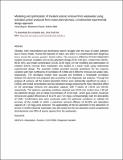| dc.description.abstract | Globally, both industrialized and developing nations struggle with the issue of water pollution due to heavy metals. Human life depends on water, and when it is contaminated with dangerous heavy metals like arsenic, people’s health suffers. The interactive influence of three independent sorption processes variables such as bio-adsorbent dosage (0.50–3.00 g/L), contact time (40.00–90.00 min), and initial concentration (10.00–30.00 mg/L) on the modeling and optimization of trivalent arsenic removal from wastewater was studied in a batch mode using multivariate experimental design. The quadratic models provided accurate predictions for the response variables with high coefficients of correlation of 0.9984 and 0.9994 for removal and uptake rates, respectively. The developed models were accurate and exhibited a remarkable correlation between the observed and projected data according to the diagnostic test analyses. Through the analysis of variance, all the studied adsorption factors were statistically significant (p-values < 0.0001) with initial concentration and bio-adsorbent dosage producing the main interactive effect on the percentage removal and adsorption capacity with F-values of 146.05 and 264.65, respectively. The optimum operating conditions attained were 90.00 min contact time, 0.50 g/L bio-adsorbent dosage, and an initial concentration of 10.00 mg/L, which gave arsenic maximum removal and uptake efficiencies of 93.14% and 7.04 mg/g, correspondingly with the desirability of 0.844. Confirmative tests were conducted under the optimized conditions to validate the accuracy of the models in which a maximum removal efficacy of 94.33% and adsorption capacity of 7.15 mg/g were achieved. The applicability of the bio-adsorbent in the adsorption of arsenic in textile industrial wastewater was also tested and the bio-adsorbent could competitively decontaminate over 99% of arsenic species from the wastewater. | en_US |

